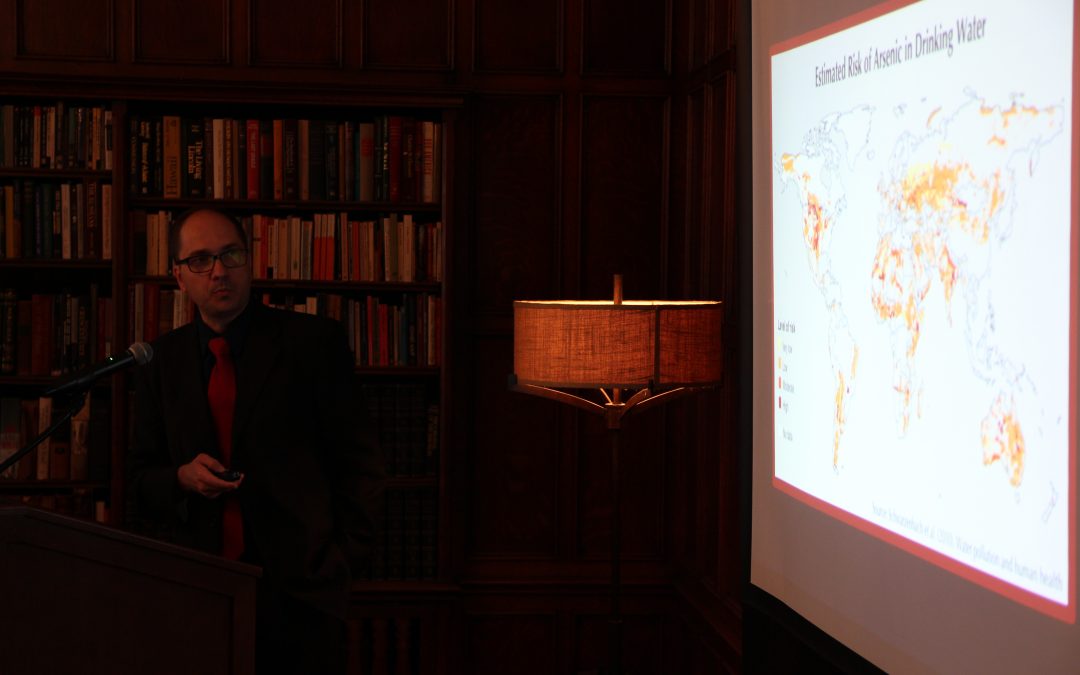Biomedical Sciences professor Robert Sargis digs below the surface of the diabetes epidemic to research the environmental determinants of the disease that are not always under our control.
By Evaline Bai (Frizzell Committee Member, 4th year, Environmental Studies and Public Policy Studies)
In the treatment of diabetes, doctors often resort to “controlling the controllable,” such as encouraging proper diet and exercise. Dr. Robert Sargis of the University of Chicago Biomedical Sciences Department, however, has spent the bulk of his career digging below the surface of the diabetes epidemic to research the environmental determinants of the disease that are not always under our control.
On Monday, May 23, at the Quadrangle Club, Dr. Sargis delivered the 2016 Frizzell Family Memorial Lecture, titled “Paradox of Progress: Environmental Origins of Diabetes”. Just prior to the lecture, Dr. Sargis engaged in small-group discussion with a collection of undergraduates spanning a variety of majors from economics and public policy to biology and environmental studies. The takeaway from both events was alarm and impassioned awareness.
Dr. Sargis explained that Type 2 Diabetes is a leading cause of blindness, kidney failure, cardiovascular disease, and adult amputation around the world, affecting 642 million people by 2020. The disease costs the U.S. economy over 300 billion dollars a year and climbing. Commonly cited risk factors such as genetic susceptibility and poor lifestyle choices do not suffice to fully explain the rapidity and magnitude of the growing diabetes epidemic. Exposure to chemical pollutants—a possible additional risk factor—can obliterate our inherent resistance to metabolic dysfunction and worsen the effects of poor diet and exercise on insulin resistance. For example, Dr. Sargis is attempting to determine whether or not certain environmental chemical contaminants may trigger the pathway of Cushing’s Syndrome, a condition caused by the inappropriate activation of glucocorticoid receptor signaling.
Historically, anthropocentric chemical usage grew out of legitimate needs such as curing insect-borne diseases and feeding a growing population. Over time, as the use of harmful chemicals became more ubiquitous throughout human society, the epidemiological impacts of these chemicals became more apparent and necessitated new research in environmental endocrinology.
The issue does not simply center on what we are putting into our bodies, but what our parents put into their bodies long before we are born. Dr. Sargis discussed evidence that organisms may inherit a chemical legacy from generations past. For example, although the chemical DDT was banned in the 1970s, around 95 percent of Americans today still maintain metabolites of DDT within their bodies.
The generational effects of chemical contamination are particularly disturbing, because this indicates that diabetes is not simply an issue of health and wellness, but also an issue of social justice. There exists an immense coincidence between the prevalence of diabetes and poverty in a given area. African-American and Hispanic communities in particular face disproportionate exposure to endocrine-disrupting chemicals in both their living environments and the products with which they interact. Diabetes is not only caused by physiological determinants, but also deeply underpinned by larger civil liberties issues such as access to nutritious foods, safe neighborhoods, the fair siting of toxic waste sites, and a living wage.
Dr. Sargis works at the intersection of biomedical research, environmental science, and social justice advocacy in an effort to understand how our industrial activities impact our epidemiological reality. Students, policymakers, and community members must now translate his research into a sound and equitable public policy. Although we no longer subscribe to the notion that “chemistry conquers all,” we can still find ways to utilize chemicals for legitimate purposes while limiting their impact on our bodies.
